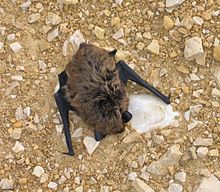Savi's pipistrelle
The Alps bat ( Hypsugo savii; Syn: Pipistrellus savii ) belongs to the family of bats within the Myotis bats and the genus Hypsugo is assigned, recently published by the Common Pipistrelle ( Pipistrellus ) was separated. It is used in large parts of Eurasia as well as in the far northwest of North Africa. The scientific species name honors the Italian zoologist Paolo Savi ( 1798-1871 ).
Features
The Alps bat reaches a head-body length of 4.0 to 5.4 cm with a tail length of 3.1 to 4.3 inches and a wingspan of 22 centimeters. Its weight is 5 to 10 grams. Making it one of the small bat species in Europe. Their fur is relatively long and at the top yellow to dark brown with black hair brown base and shiny hair. The belly is white-yellow to gray-white and differs significantly from the top off. Ears and muzzle are almost black, dark brown wings. The flight-capable juveniles are slightly darker than the adult animals and have little or no bright hair.
Compared to the European Common Pipistrelle ( Pipistrellus ) the ears are larger and rounder, they have four ear folds. The ear length is 10 to 15 millimeters. The tragus is short and widens upward slightly at the base, he has two opposing teeth and the rounded tip has turned inward.
The arm has a length of 30.0 to 36.5 millimeters. The Armflughaut attaches to the carpus. The calcar ( spur ) or the tail wing membrane has a narrow Epiblema without a visible web. The last two caudal vertebrae are free to 3-5 millimeters in length.
Distribution and habitat
The Alps bat has a very large paläarktisches distribution area, ranging from the far northwest of North Africa and southern Europe over the entire range of Mittlerer East and the Caucasus to northern India, Kazakhstan, Turkmenistan, Uzbekistan, Kyrgyzstan, Tajikistan and Afghanistan. About hikes are few data, however, they are accepted for Europe. In this case, no walks but have so far been detected over 250 kilometers.
Way of life
Nutrition
The animals usually fly well before sunset and hunt during the night. Their diet consists of various insects, especially of butterflies, dipterans such as mosquitoes, Hymenoptera, Netzflüglern and small beetles. This they probably hunt exclusively in flight with echolocation sounds 31-35 kHz. The search for food is usually at a higher altitude over an open woodland and on pasture and wetlands instead. However, they also live in inhabited areas, especially in southern Europe in cities, where they begin, among others, in the field of lighting systems insects. They also hunt near cliffs or treetops.
Your quarters and rest areas can be found in rock crevices, but also in cracks of buildings or under tree bark. Very rarely they are found in subterranean habitats and caves.
Reproduction and Development
The mating season of the Alps bat is approximately between late August and late September.
The females form maternity roosts with 20 to 70 individuals, but are also those with a five to ten females. The young are born in early to mid July to the world, rarely earlier. Typically, a female gives birth to two pups, in rare cases even one. At birth These weigh about 1.2 grams.
System
The Alps bat is with 14 other species from Africa and Asia assigned to the genus Hypsugo, caused by the genus of Pipistrelle bats ( Pipistrellus ) was separated.
Threat and protection
The species is classified ( Least concern ) globally as " not threatened " by the International Union for Conservation of Nature and Natural Resources ( IUCN) due to the large distribution area and population size. A decline in inventories and a greater threat to the species are not known. National and regional is the way in many countries under protection.









